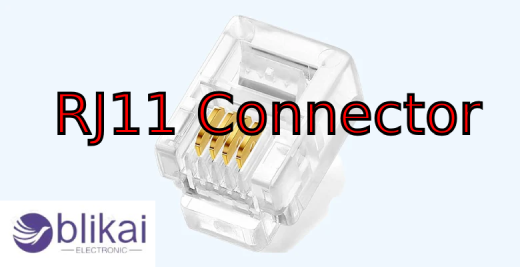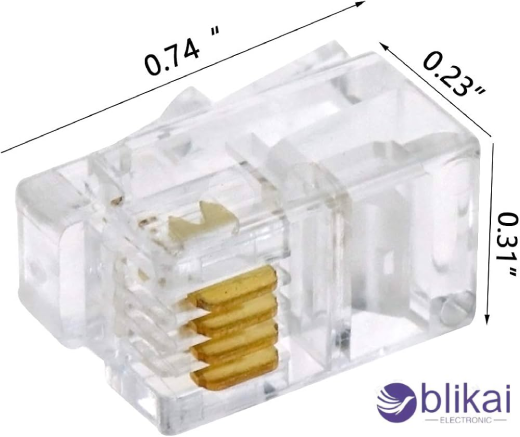What is RJ11 Connector & How it Work?
What an RJ11 Connector?
Have you ever thought about that small, everyday plug you use to hook up your landline phone? Well, let me tell ya, that's an RJ11 connector! These little fellas have been around for ages, helping our voices travel through telephone lines smoothly. But what exactly are they, and how do they make work so well? Let's dive in & uncover the secrets of the RJ11 connector!

Physical Characteristics of RJ11 Connectors
Size and Shape:
Imagine a small, rectangular plug with a clip on top. That's your RJ11 connector! It's pretty compact, right? Measuring about 9.65mm wide & 6.35mm high. Tiny but mighty!
Number of Pins:
Here's where it gets cool. An RJ11 connector usually has six slots, but–surprise–it typically uses only four of them! The two center pins are the main players here, carrying the actual phone signals.

Materials Used:
These connectors are typically composed of durable plastic with metal contacts for the pins. After all, nobody wants their phone connection to drop just 'cause they moved their phone around too much!
How RJ11 Connectors Work
Pin Configuration:
Alright, let's dive in a little (but not too deep, I promise!). So, the RJ11 connector uses a 6P4C setup. That's just fancy talk for "6 positions, 4 contacts." The two middle pins (pins 3 and 4) do the heavy lifting, carrying the ring & tip signals which are super important for telephone chats.
Signal Transmission:
When an RJ11 connector is plugged in, it forms a circuit. Your voice? It turns into electrical signals. These signals then zoom through the wires connected to those pins. It's like a super-fast, invisible messenger carrying your words to someone on the other end of the call!
Common Uses of RJ11 Connectors
Telephone Connections:
This is the RJ11's chuck & adulation. It's the go-to connector for landline phones in numerous places around the world. Each time you your home phone, an RJ11 connector plays a role.
Fax Machines:
Remember fax machines? (If you're too young, ask your parents!) These relics of office technology also use RJ11 connectors to send and receive those grainy black-and-white documents.
Modems:
During the era of dial-up internet (cue that screeching modem sound), RJ11 connectors were our bridge to the internet. They linked our modems to phone lines, opening up a vast digital universe.
Advantages of RJ11 Connectors
RJ11 connectors are generally used for telephone lines & other low-speed data connections. Then are some notable advantages of RJ11 connectors:
1. Compact Size
-RJ11 connectors are small and lightweight, making them ideal for space-constrained environments like home and office phone setups.
2. Ease of Use
-The connectors are designed for easy insertion and removal. Their clip mechanism ensures a secure connection while still allowing for quick disconnection when needed.
3. Low Cost
-RJ connectors are inexpensive to & widely available. As a result, they offer a cost-effective solution for telecommunications applications.
4. Standardization
-RJ11 is a globally accepted standard for telephone systems, ensuring compatibility with numerous devices and systems across various countries.
5. Simple Wiring
-Typically, RJ11 connectors use a 2-wire or 4-wire configuration (depending on the application). This makes the wiring process straightforward, reducing the complexity of installation.
6. Reliable for Voice Communication
-The RJ11 connector is optimized for voice transmission, offering good sound quality for telephony applications when used with analog phone lines.
7. Widely Used in DSL Systems
-Conveniently merges voice & data services over DSL connections.
8. Durability
-Can handle repeated plugging/unplugging without significant wear.
Disadvantages of RJ11 Connectors
1. Limited Bandwidth: RJ11 connectors support lower data rates (typically 56 Kbps for dial-up modems), making them unsuitable for high-speed internet or modern data communication requirements.
2. Fewer Pins: RJ11 connectors have only 4 or 6 pins, limiting the number of signal pairs. This makes them less protean than RJ45 connectors(which have 8 legs) for data-ferocious operations.
3. Obsolescence: With the arrival of broadband, fiber-optic, and wireless dispatches, RJ11 connectors have come outdated for utmost data transmission tasks, relegated primarily to heritage telephone systems.
4. Limited Use Cases: They are primarily designed for voice and basic data communication (e.g., analog phone lines), lacking compatibility with Ethernet networks or advanced digital communication systems.
5. Lower Durability: When compared to more durable connectors like RJ45, RJ11 connectors tend to wear out faster with repeated use. This wear lead to unreliable connections over time.
6. Electrical Interference: The design of RJ11 connectors, along with their cables, them more vulnerable to electrical interference. This is especially true over longer distances & can lead to signal degradation.
7. No Shielding: Frequently, RJ11 cables do not have shielding. This makes them more susceptible to external electromagnetic(EMI), especially in noisy surroundings, which can affect connection quality.
RJ11 Connector vs. RJ12 vs. RJ45
|
Feature |
RJ11 |
RJ12 |
RJ45 |
|
Full Name |
Registered Jack 11 |
Registered Jack 12 |
Registered Jack 45 |
|
Connector Type |
Telephone connector |
Telephone connector |
Ethernet/network connector |
|
Pin Configuration |
6P2C (6 positions, 2 contacts) |
6P6C (6 positions, 6 contacts) |
8P8C (8 positions, 8 contacts) |
|
Common Usage |
Landline telephones |
Telephone systems (multi-line) |
Ethernet cables, computer networks |
|
Wiring |
2 wires for voice |
6 wires (supports data, voice) |
4 pairs of twisted-pair cables |
|
Data Transmission Speed |
Slow (telephone signals) |
Slow (telephone signals) |
High-speed (10/100/1000 Mbps) |
|
Max Distance |
Short distances (few meters) |
Short distances (few meters) |
Can extend up to 100 meters (Ethernet) |
|
Physical Size |
Smaller than RJ45 |
Same as RJ11 |
Larger than RJ11/RJ12 |
|
Key Applications |
Single phone lines |
Business phone systems |
LAN, Internet connectivity |
Installing RJ11 Connectors
Tools Required:
To install an RJ11 connector, you'll need wire strippers, an RJ11 releasing tool & the connector itself.
Step-by-Step Guide:
1. Strip the outer jacket of your telephone cable.
2. Arrange the inner wires according to the standard color code.
3. Insert the wires into the RJ11 connector.
4. Use the crimping tool to secure the connection.
5. Test your handiwork with a phone line tester.
Troubleshooting RJ11 Connection Issues
Occasionally, effects do not go as planned.However, do not worry! First, check if the connector is properly plugged in—sounds obvious, right? But you'd be surprised how often this is the problem! If that doesn't solve it, inspect the cable for any damage. Sometimes, a pet or a vacuum cleaner can be the hidden cause.
Conclusion
Although not the fastest or most advanced option today, the humble yet essential role of the small but vital unsung hero—the RJ11 connector—remains relevant since its creation in the '70s due to its significant contribution to global telecommunication functionality.
FAQs of RJ11 Connector
1. Can I use an RJ11 connector for my internet connection?
No—they were only used for dial-up previously; contemporary connections usually employ connectors—specifically those associated with Ethernet protocols commonly known as type 'RJ45'.
2. Are RJ11 and RJ12 connectors interchangeable?
They generally are; however usage six-pins vs four respectively results inversely unless otherwise specified mismatch/harm occurs making removing contact points suitable instance altogether.
3. How long can an RJ11 cable be before signal quality degrades?
So, generally, you can stretch an RJ11 string over to 100 bases(30 measures) without important hassle. Past that length, well, you'll likely need a signal booster to keep things running smoothly.
4. Can I repair a broken RJ11 connector?
Sure, you can fix a broken RJ11 connector. But honestly, it's a lot simpler & often better to just swap it out for a new one.
5. Is it difficult to install an RJ11 connector myself?
Well, with the right tools and a bit of patience, putting on an RJ11 connector isn't too tough—really, it's not. Still, if you're feeling unsure (which is totally okay), probably best to ask a pro for help.
Related Articles
RJ45 vs RJ11: What's the Main Differences? (Guide)
What do Microminiature and Ultraminiature RF connectors entail?
Mastering RJ45 Connectors: A Comprehensive Handbook
Isolator vs Switch Disconnector: What's the Main Differences?
What a Human Machine Interface system is and How it works
What Is Network Interface Card: Applications and Functions
Linear Actuators: Types, Advantages, and Applications
Optical Line Protection in Modern Networks: Full Guide
Dual In-Line Memory Modules(DIMM): Advancements and Applications
Capacitance Calculator: Online Free Calculator for You
Inductor vs Resistor: What’s the Differences?
What Causes Capacitors to Fail
What is the Standard Lead Spacing for Capacitors?
What are Lighting Ballasts?










